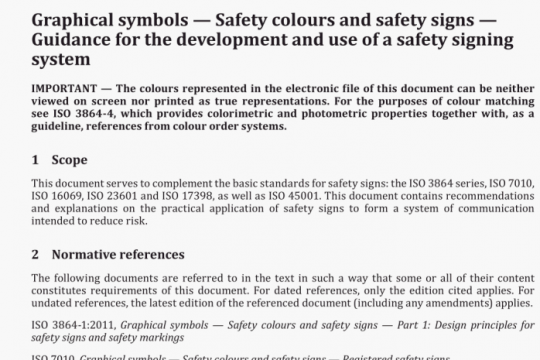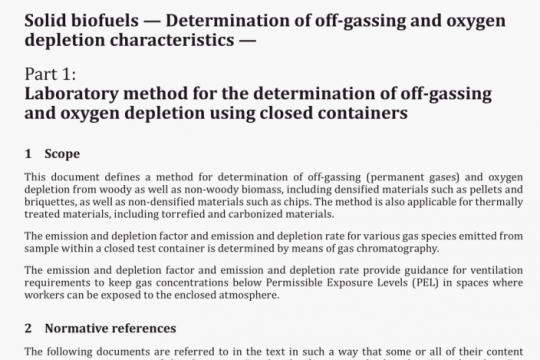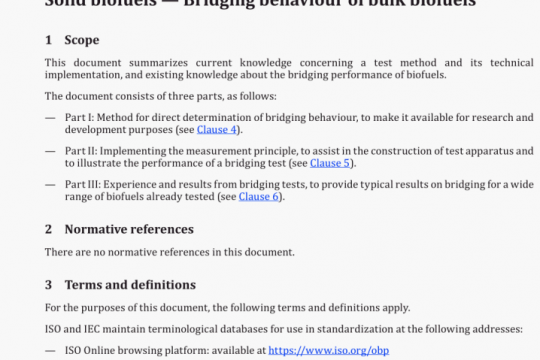BS EN ISO 9229 pdf free download
BS EN ISO 9229-2020 pdf free download.Thermal insulation – Vocabulary.
This document provides a vocabulary of terms used in the field of thermal insulation that covers materials, products, components and applications. Some of the terms can have a different meaning when used in other industries or applications.
2 Normative references
There are no normative references in this document.
3 Terms and definitions
For the purposes ofthis document, the following terms and definitions apply.
ISO and IEC maintain terminological databases for use in standardization at the following addresses:
— ISO Online browsing platform: available at https://www.iso.org/obp
— IEC Electropedia: available at http://www.electropedia.org/
3.1 Thermal insulation materials
3.1.1 thermal insulation material
substance that is intended to reduce heat transfer and that derives its insulation properties from its chemical nature, its physical structure or both
3.1.2 cellular plastic
thermal insulation material (3.1.1) made from plastic, in which the density is reduced by the presence of numerous small cavities (cells), which may be interconnecting or not, dispersed throughout the material
3.1.2.1expanded polystyrene EPS
rigid cellular plastic (3.1.2) thermal insulation material (3.1.1) manufactured by moulding beads of expandable polystyrene or one of its co-polymers and that has a substantially closed-cell structure, filled with air
3.1.2.2 extruded polystyrene foam xPs
rigid cellular plastic (3.1.2) thermal insulation material (3.1.1) made from polystyrene or one of its copolymers, which has a closed-cell structure and is produced through an extrusion process
3.1.2.3 flexible elastomeric foam FEF
pliable thermal insulation product (3.2.1) made of natural or synthetic rubber, or a mixture of the two, and containing other polymers and other chemicals that may be modified by organic or inorganic additives
3.1.2.4 phenolic foam PF
rigid cellular plastic (3.12) thermal insulation material (iLl), the polymer structure 01 which is made primarily from the poly-condensation of phenol, its homologues and/or derivatives with aldehydes or ketones
3.1.2.5 polyethylene foam PEF
semi-rigid or flexible cellular plastic (3.1.2) thermal insulation material (3.1.1) based on polymers derived mainly from ethylene and/or propylene
3.1.2.6 polyurethane foam PUR
rigid or semi-rigid cellular plastic (3.1.2) thermal insulation material (3.1.1) with a substantially closed- cell structure based on polyurethanes
3.1.2.7 urea formaldehyde foam UF
cellular plastic (3.1.2) thermal insulation material (3.1.1) with a substantially open-cell structure, based on an amino resin made by the polycondensation of urea with formaldehyde
3.1.2.8 expanded polyvinyl chloride
rigid or semi-rigid cellular plastic (3.1.2) thermal insulation material (3.L1) based on vinyl chloride polymers expanded to form a cellular structure consisting substantially of closed cells
3.1.2.9 polyisocyanurate foam PIR
rigid cellular plastic (3.1.2) thermal insulation material (3.1.1) with a substantially closed-cell structure based on polymers mainly of the isocyanurate type
3.1.3 cellular glass
CG rigid thermal insulation material (3.1.1) made from expanded glass with a closed-cell structure
3.1.4 calcium silicate Cs
thermal insulation material (3.1.1) comprised of calcium oxide and silicon dioxide, normally reinforced by incorporating fibres
3.1.5 aluminosilicate wool
ASW
amorphous high temperature insulating wool (HTIW) predominantly produced by melting a combination of A1203 and Si02, and may contain Zr02 and Cr203
3.1.6 magnesia
thermal insulation material (3.1.1), composed principally of basic magnesium carbonate that incorporates fibre as a reinforcing agent.BS EN ISO 9229 pdf download.




